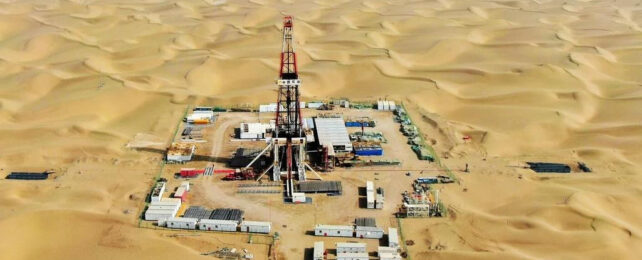There are a lot of ways that scientists can figure out what's going on beneath Earth's surface – like measuring seismic waves as they travel underground – but perhaps nothing beats a really, really, really deep hole.
As per China's state-run Xinhua news agency, work is now underway to dig a 11,100-meter (36,417-foot) borehole in the Taklamakan Desert in northwest China. That's the equivalent of more than 33 Eiffel Towers, stacked on top of each other.
This isn't quite the deepest humans have ever been. The new dig won't beat the 12,262-meter (40,230-foot) Kola Superdeep Borehole in Russia (which is now abandoned), or the 12,290-meter (40,323-foot) BD-04A oil well in the Al Shaheen Oil Field in Qatar – but it's getting close.
Chinese scientists are hoping that the hole will significantly improve our understanding of deep Earth geology, while searches for oil and gas reserves will also be carried out as the drilling goes to lower and lower depths.

China hasn't revealed too much more about the details of the borehole, or the sorts of experiments and analysis that will result when it's finished, but it could help to verify what we think we know about Earth's crust. Continental crust goes down to depths averaging about 30 kilometers (over 18 miles), so this hole won't hit the mantle.
It's a huge technical undertaking, as you can imagine. The hole won't be completed for more than a year, and some 2,000 tonnes of equipment and instruments – including drill bits and drill pipes – have been brought in for the job.
For an idea of how difficult drilling to these depths can be, look at the Kola Superdeep Borehole. Work on that project began in May 1970 and went on until 1994, with five boreholes excavated in total due to mechanical failures and breakdowns.
It proved very useful though: Scientists found water and hydrogen in quantities and at depths that they weren't expecting. Another interesting discovery was the presence of microscopic plankton fossils about 6,000 meters (19,685 feet) below the surface.
"The construction difficulty of the drilling project can be compared to a big truck driving on two thin steel cables," scientist Sun Jinsheng from the Chinese Academy of Engineering told Xinhua.
The equipment being put to use to create the borehole is going to have to withstand temperatures up to 200 degrees Celsius (392 degrees Fahrenheit), and atmospheric pressure some 1,300 times higher than it is at the surface.
When it's completed, in an expected 450 days (approximately), the new hole in China will pass through 10 continental strata – the layers of sedimentary rock that stretch over entire continents – all the way back to the Cretaceous System, formed as far back as 145 million years ago.
